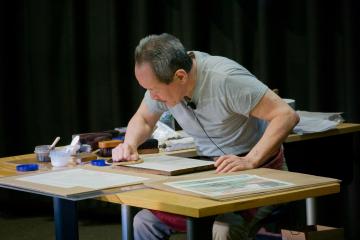Layers of Tradition: Exploring the Art of Japanese Woodblock Printmaking
Hosted by the co-curators of Textured Stories: Chirimen Books of Modern Japan, part of the Insight into Meiji Japanese Art, Books, and Prints program, and the Council on East Asian Studies at the Yale MacMillan Center, a live woodblock printmaking demonstration invited audiences to observe and learn the meticulous craft of master printmaker Keiji Shinohara, whose career bridges traditional Japanese artistry and contemporary global practice.
Shinohara began by walking the audience through the intricate and intensive design process of creating a print from idea to artwork. He explained that it takes many years of dedicated training to begin printing the design used in the demonstration. In this method, the final print is composed in multiple stages, where parts of the image like the hair are printed with one woodblock and the design of the kimono another woodblock. For this demonstration, he started with nine stages of the design already completed and had five more to go. Without the prep work, “the whole print would take four hours start to finish,” he noted. Through this demonstration, Shinohara revealed an artistic philosophy grounded in precision, patience, and reverence for craft.
Using horsetail hairbrushes and different sized baren (馬連), a circular hand tool that contains a coiled fiber pad used to apply even pressure, Shinohara demonstrated how each element, including color, detail, and shading, is added sheet by sheet. He described how he oils the baren by wiping it along his cheek, applies ink, and sometimes uses rice paste to control texture and tone. The baren is used to transfer the ink evenly from the woodblock, and Shinohara explained two main techniques for achieving gradated tones that bring subtle variation to the final image.
Reflecting on his apprenticeship, Shinohara shared that he began his training in traditional printmaking in 1975. A native of Osaka, Japan, he apprenticed for ten years under the renowned ukiyo-e printer Keiichiro Uesugi in Kyoto before becoming a master printmaker and moving to the United States in 1985. He explained that an artist becomes a master under the guidance of their teacher. Once he became a master, Shinohara began contracting work and would return a portion of his wages to his teacher as a gesture of gratitude and repayment for his years of instruction. He added that he was his teacher’s last student.
Shinohara also discussed how physical adaptation is part of mastery. Naturally left-handed, he had to learn to print right-handed, emphasizing that precision requires both discipline and humility. He recalled how his teacher could tell when a student was printing incorrectly just by the sound of the baren on the paper. Every action, from how the brush meets the block to how moisture interacts with pigment, reflects a deep respect for the materials and their cultural lineage.
Since 1995, he has taught at Wesleyan University and has presented his work at more than 100 venues worldwide, including 40 solo exhibitions. His work is held in major public collections such as the Legion of Honor in San Francisco, the Cleveland Museum of Art, the Fogg Art Museum at Harvard University, the Milwaukee Art Museum, the Library of Congress, and the National Museum of Asian Art at the Smithsonian Institution.


